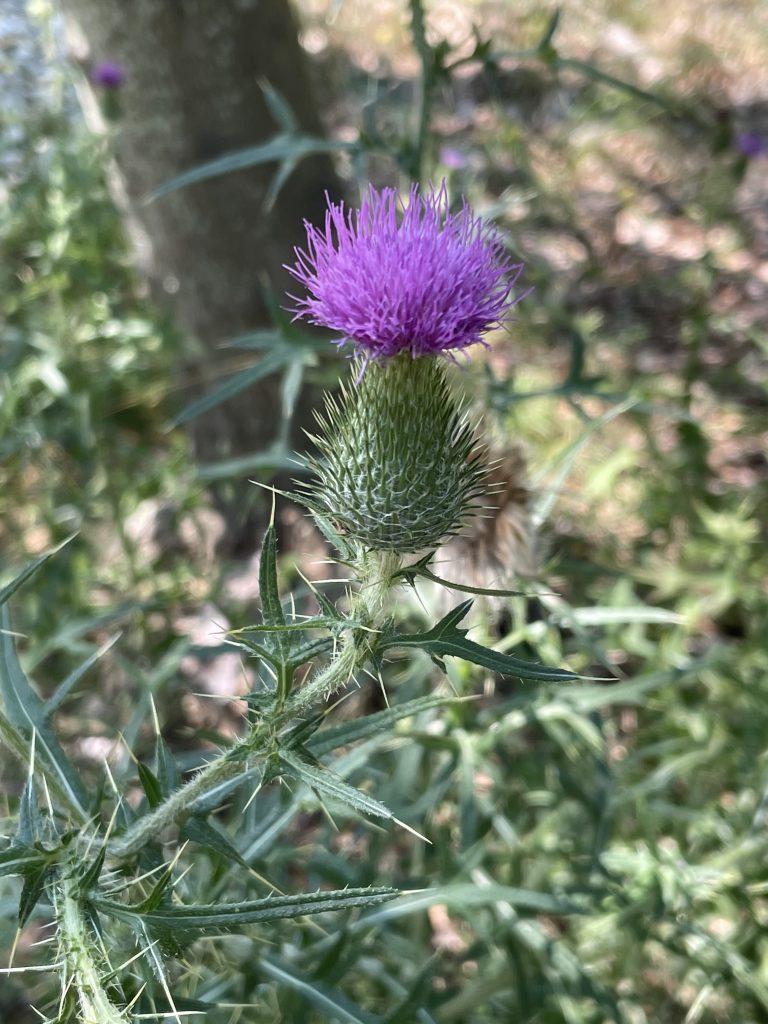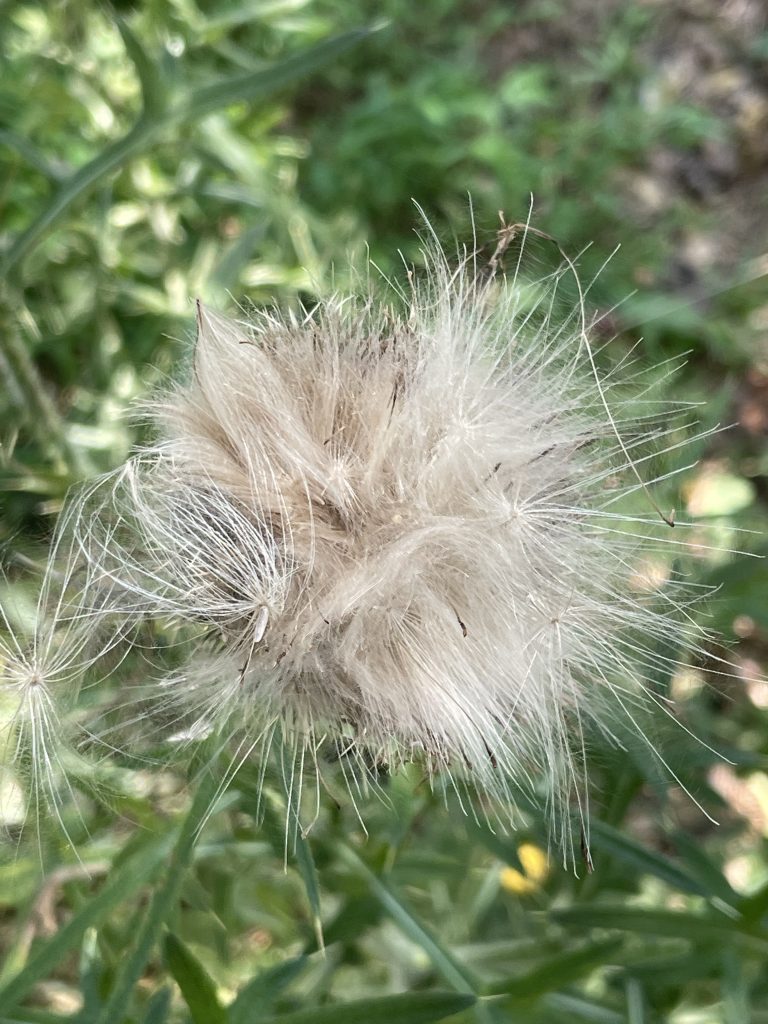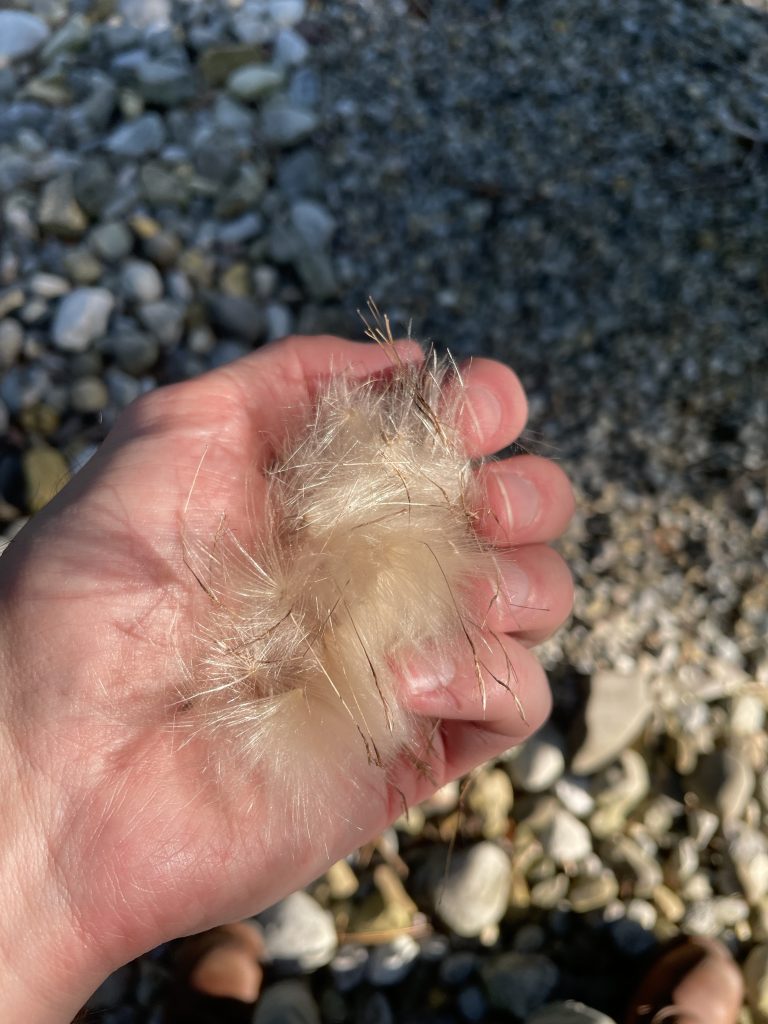
This is a common thistle (also known as a bull thistle or spear thistle). It is a species of thistle that is native to the Old World and naturalized in my area of the country. Due to its extraordinary resilience, it is probably a cosmopolitan species.
Landscapers, gardeners, and some uneducated homeowners hate them, but I love them, and not just because they are such functional, useful plants.
I love the thistle primarily because it is the flower of Scotland, from which some of my ancestors hail. It is a spiny, curmudgeonly plant with unforgiving tendencies. If you’ve ever had a bad experience with a cactus, just wait until you have an intimate brush with a thistle. The spines are needle sharp and the plants cannot even be handled with gloves. The spines will pierce right through even thick leather.
There is no surface on the plant that can be grasped without fear of drawing quite a few drops of blood. Thistles are a testament to uncompromising will in downright hostile locations. They grow in hot areas, they grow in cold areas, they grow in dry areas, they grow in waste areas. They are among the toughest “weeds” on the planet, and one of the few that even deer won’t eat.
But character is also vested with uncommon beauty in the thistle. In mid to late summer the pretty pink blossoms dot the roadsides and are a gem to those that slow down sufficiently to drink in their coquettish humor; look, but don’t touch!
They remind me that beauty and resolve can cohabit in the same form, and possess a certain wild spirit that is rare among other wild plants and utterly absent among ornamentals. Man, the horticulturist, imitates. God, the author, makes.
The thistle is also a beautiful plant because it attracts butterflies, bees, and, closest to my heart, Eastern Goldfinches. Late in summer, when the local thistles mature and the flowers go to seed, the cheery, airy notes of the congregant goldfinches couched happily aloft in the highest blooms of the thistle plants come wafting in on the breeze.
But you’re here for new ways to do old things, and this post is going to focus on the bounty of nature – among the greatest uses for thistledown, as tinder.
What Is Thistledown?

Thistledown (don’t confuse it with the chemical monstrosity produced as a weedkiller) is the thin, white, fibrous material that supports the seeds in the ovaries of the flowers. It is produced during the development of the plant’s seeds and only matures once the flowerhead dies. It cannot be harvested until the blossoms brown and the calyx starts to split.
I have heard stories that milkweed down, which is like thistledown, is excellent as a buoyant material with which life vests can be stuffed. I have also read that it is a good insulator. However, one of the best uses for thistledown (that I have found) is as tinder.
How to Harvest It? [and When?]

Don’t even waste your time trying to harvest thistledown from immature flowers. All you’ll get for your pain is, well, a lot of pain, literally. The spines on the calyx of the flower are the sharpest and nastiest of them all.
Wait for the flower heads to turn brown and split open, which will take several days to longer than a week in some instances. Once that happens, you won’t even need to touch any of the parts of the plant that will give you grief.
Once the filaments of the flower turn brown and the flower splits, pull on the loose ends of the flower and the down will slough right off into your hands. Keep this somewhere warm and dry and you’re good to use it for tinder – that’s all there is to it!
Note: do not cut flowers in the prime of their bloom and hang them to dry with the intention of harvesting the thistledown later. It will not develop, robbing you of the opportunity of harvest in the first place. Moreover, you’ll be taking away all that food from the bees, birds and butterflies! Let the plant do the hard work and just harvest the down when the plant is ready.
Tinder: One of the Greatest Uses for Thistledown

If you’re out in the woods in late summer, camping, and need a quick source of tinder that will light as readily as charcloth, and you’re near thistles, you’re in luck.
Pull out a handful of the thistledown you collected and prepare your kindling pile and fuel. Arrange your fire and place your thistledown in a ball under it. Strike a few sparks into it and enjoy the result – it’s one of the easiest natural tinders to light and can be gathered by the handful in late summer.
Looks like there’s another use for the CJRB Maileah – I told you it was good for striking sparks!
Enjoy the blossoms, remember this when you wonder about practical uses for thistledown, and be safe.
~The Eclectic Outfitter
Thankyou for your comments. I like thistles also.
Glad you found it helpful. I love thistles because they are beautiful – and I have Scottish heritage so there’s some personal symbolism there for me. They’re a bit prickly to handle, but comely, and I love that the birds and butterflies love them. Add in the fact that you can make fire from it and you have a slam dunk. Thanks for reading!